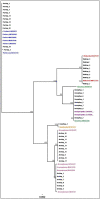Spatio-temporal changes in endosymbiont diversity and composition in the African cassava whitefly, Bemisia tabaci SSA1
- PMID: 36466669
- PMCID: PMC9715980
- DOI: 10.3389/fmicb.2022.986226
Spatio-temporal changes in endosymbiont diversity and composition in the African cassava whitefly, Bemisia tabaci SSA1
Abstract
Sap-sucking insects, including whiteflies, are amongst the most devastating and widely distributed organisms on the planet. They are often highly invasive and endosymbiont communities within these insects help them adapt to new or changing environments. Bemisia tabaci (Gennadius; Hemiptera: Aleyrodidae) whitefly species are vectors of more than 500 known plant-viruses and harbour highly diverse endosymbionts communities. To date, however, whitefly-endosymbiont interactions, community structure and their spatio-temporal changes are still poorly understood. In this study, we investigated the spatio-temporal changes in the composition and diversity of bacterial endosymbionts in the agricultural crop pest whitefly species, Bemisia tabaci sub-Saharan Africa 1-subgroup 1 and 2 (SSA1-SG1 and SSA1-SG2). 16S rRNA amplicon sequencing analysis was carried out to characterise endosymbiont compositionsin field-collected SSA1 (SSA1-SG1 and SSA1-SG2) populations infesting cassava in Uganda in 1997 and 2017. We detected Portiera, Arsenophonus, Wolbachia, Hamiltonella and Hemipteriphilus, with Arsenophonus and Wolbachia infections being predominant. Hemipteriphilus and Hamiltonella frequencies were very low and were detected in seven and two samples, respectively. Bacterial diversity based on three independent parameters including Simpson index, number of haplotypes and Bray-Curtis dissimilarity matrix was significantly higher in 1997 than in 2017. This period also coincided with the advent of super-abundant cassava-whitefly populations on cassava crops in Uganda. We discuss how endosymbionts may influence the biology and behaviour of whiteflies leading to population explosions.
Keywords: Illumina HiSeq; cassava; endosymbionts; temporal change; whitefly.
Copyright © 2022 El Hamss, Maruthi, Ally, Omongo, Wang, van Brunschot, Colvin and Delatte.
Conflict of interest statement
The authors declare that the research was conducted in the absence of any commercial or financial relationships that could be construed as a potential conflict of interest.
Figures






Similar articles
-
Outbreak-driven differences in the microbiome composition and diversity of two cassava whitefly Bemisia tabaci mitotypes SSA1-SG1 and SSA1-SG2.Front Microbiol. 2025 Jul 11;16:1597836. doi: 10.3389/fmicb.2025.1597836. eCollection 2025. Front Microbiol. 2025. PMID: 40718815 Free PMC article.
-
Genetic Diversity of Whiteflies Colonizing Crops and Their Associated Endosymbionts in Three Agroecological Zones of Cameroon.Insects. 2024 Aug 30;15(9):657. doi: 10.3390/insects15090657. Insects. 2024. PMID: 39336625 Free PMC article.
-
Microbiome diversity and reproductive incompatibility induced by the prevalent endosymbiont Arsenophonus in two species of African cassava Bemisia tabaci whiteflies.Ecol Evol. 2021 Dec 1;11(24):18032-18041. doi: 10.1002/ece3.8400. eCollection 2021 Dec. Ecol Evol. 2021. PMID: 35003655 Free PMC article.
-
Whitefly Endosymbionts: Biology, Evolution, and Plant Virus Interactions.Insects. 2020 Nov 10;11(11):775. doi: 10.3390/insects11110775. Insects. 2020. PMID: 33182634 Free PMC article. Review.
-
Whitefly endosymbionts: IPM opportunity or tilting at windmills?J Pest Sci (2004). 2022;95(2):543-566. doi: 10.1007/s10340-021-01451-7. Epub 2021 Nov 2. J Pest Sci (2004). 2022. PMID: 34744550 Free PMC article. Review.
Cited by
-
Outbreak-driven differences in the microbiome composition and diversity of two cassava whitefly Bemisia tabaci mitotypes SSA1-SG1 and SSA1-SG2.Front Microbiol. 2025 Jul 11;16:1597836. doi: 10.3389/fmicb.2025.1597836. eCollection 2025. Front Microbiol. 2025. PMID: 40718815 Free PMC article.
-
Genetic Diversity of Whiteflies Colonizing Crops and Their Associated Endosymbionts in Three Agroecological Zones of Cameroon.Insects. 2024 Aug 30;15(9):657. doi: 10.3390/insects15090657. Insects. 2024. PMID: 39336625 Free PMC article.
References
-
- Akintola A. A., Hwang H.-S., Khatun M. F., Ande A. T., Lee K.-Y. (2020). Genetic diversity of Bemisia tabaci cryptic species in Nigeria and their relationships with endosymbionts and acquired begomoviruses. J. Asia Pac. Entomol. 23, 1003–1009. doi: 10.1016/j.aspen.2020.08.007 - DOI
LinkOut - more resources
Full Text Sources
Miscellaneous

